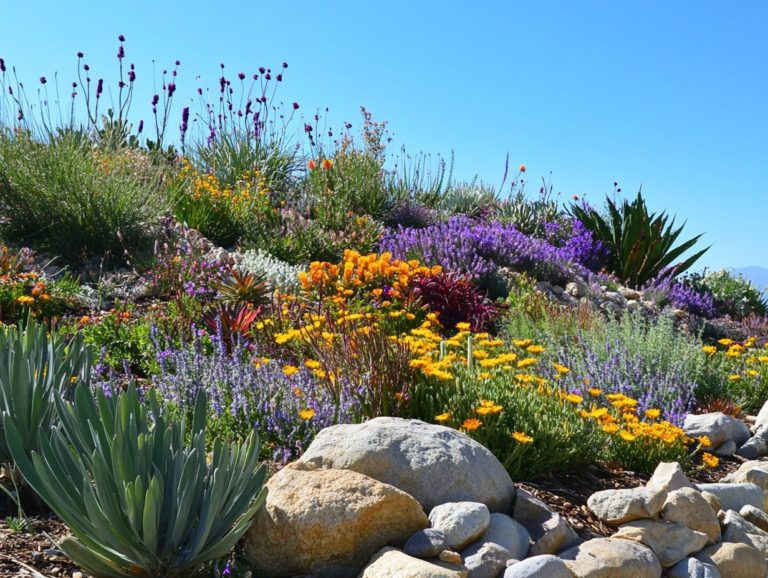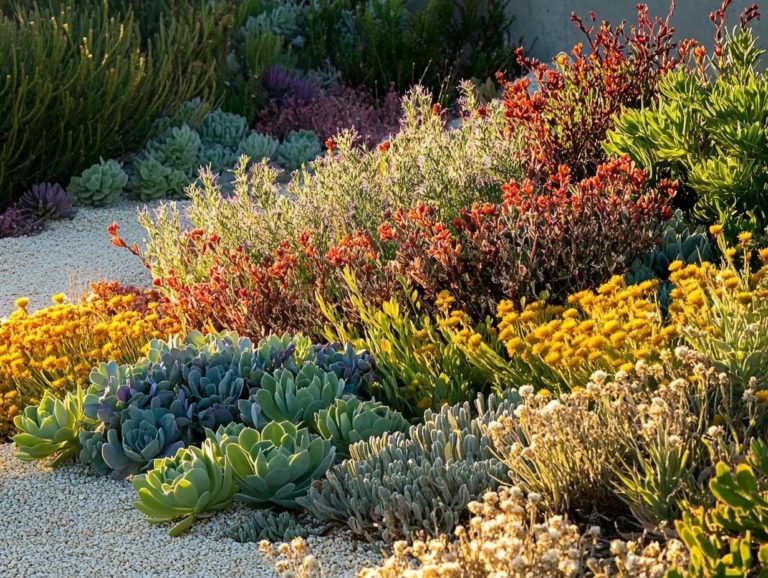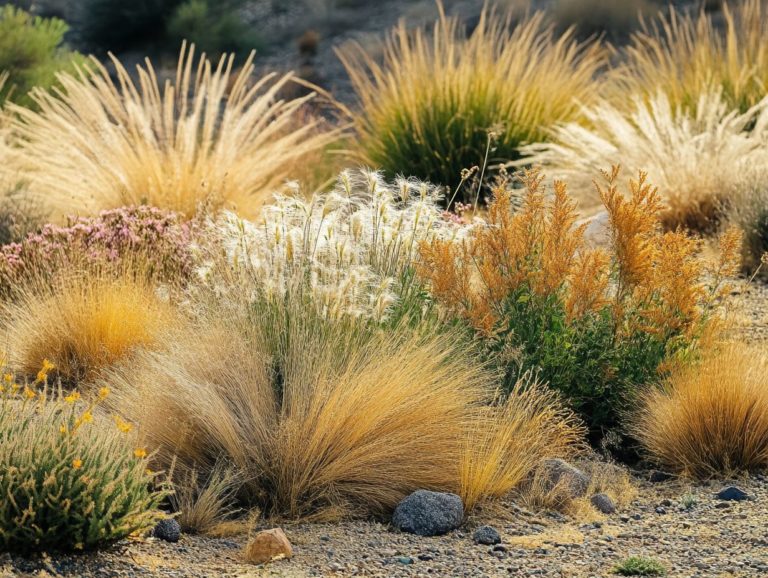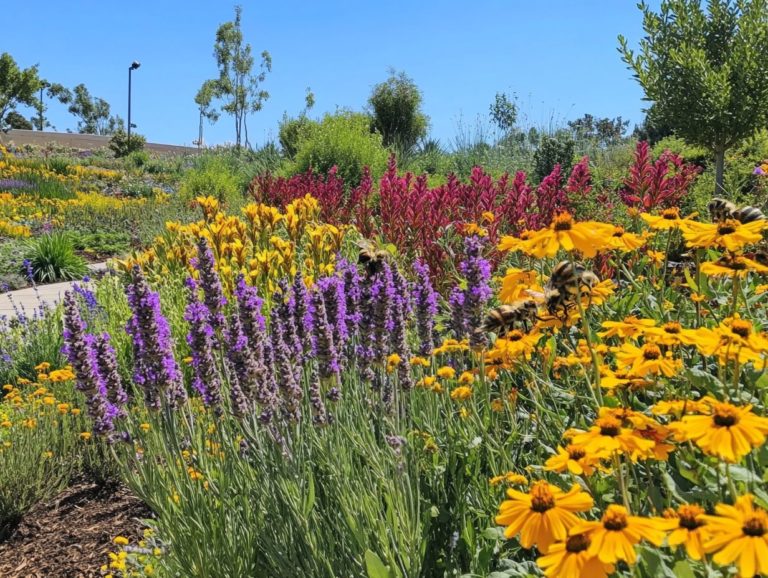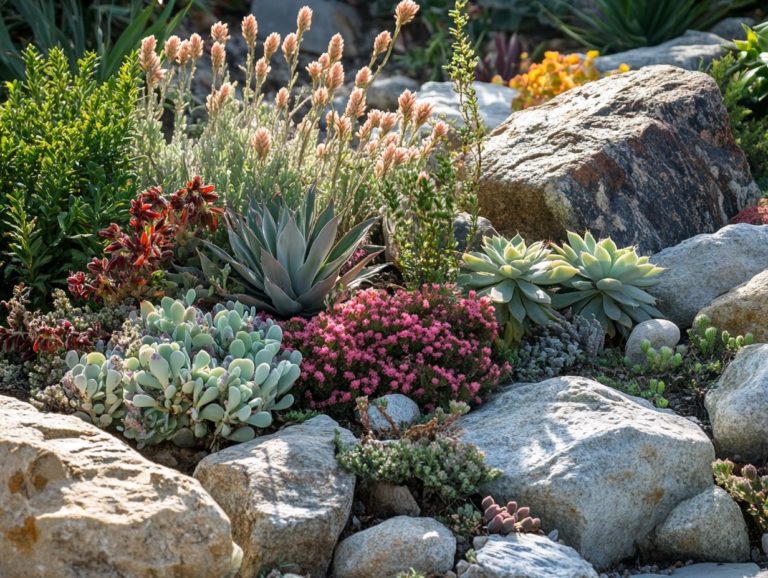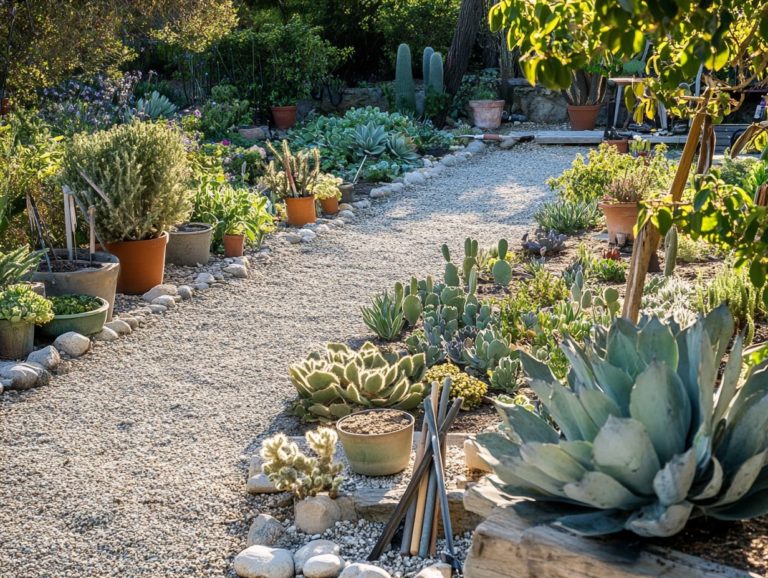10 Drought-Resistant Plants for Coastal Areas
Coastal gardens possess an undeniable beauty, yet they frequently contend with challenges like salty air and limited water.
Fortunately, you have a wealth of stunning drought-resistant plants at your disposal, perfectly suited for these conditions. This article delves into ten remarkable species, ranging from the vibrant bougainvillea to the resilient agave, all capable of thriving in harsh coastal climates while elevating the aesthetics of your landscape.
You ll learn about their maintenance needs, environmental benefits, and tips for adding them to your garden easily.
Let s start creating your beautiful, water-saving coastal oasis today!
Contents
- Key Takeaways:
- 1. Agave
- 2. Lavender
- 3. Sea Holly
- 4. Yucca
- 5. Rosemary
- 6. Russian Sage
- 7. Succulents
- 8. Verbena
- 9. Lantana
- 10. Bougainvillea
- What Makes These Plants Drought-Resistant?
- How Do These Plants Thrive in Coastal Areas?
- What Are the Maintenance Requirements for These Plants?
- How Do These Plants Enhance the Aesthetics of Coastal Landscapes?
- Are There Any Potential Risks or Drawbacks of These Plants?
- How Can Homeowners Incorporate These Plants into Their Gardens?
- What Are Some Other Drought-Resistant Plants That Can Thrive in Coastal Areas?
- How Can These Plants Benefit the Environment?
- What Are Some Tips for Successfully Growing and Caring for These Plants in Your Coastal Garden?
- What Are the Best Ways to Conserve Water in Coastal Landscapes with Drought-Tolerant Plants?
- Frequently Asked Questions
- What Are Some Examples of Drought-Resistant Plants for Coastal Areas?
- Are Drought-Resistant Plants Suitable for All Climates?
- Why Are Drought-Resistant Plants Recommended for Coastal Areas?
- Do Drought-Resistant Plants Require Any Special Care?
- Can Drought-Resistant Plants Be Used for Landscaping in Coastal Areas?
- Do Drought-Resistant Plants Attract Wildlife?
Key Takeaways:
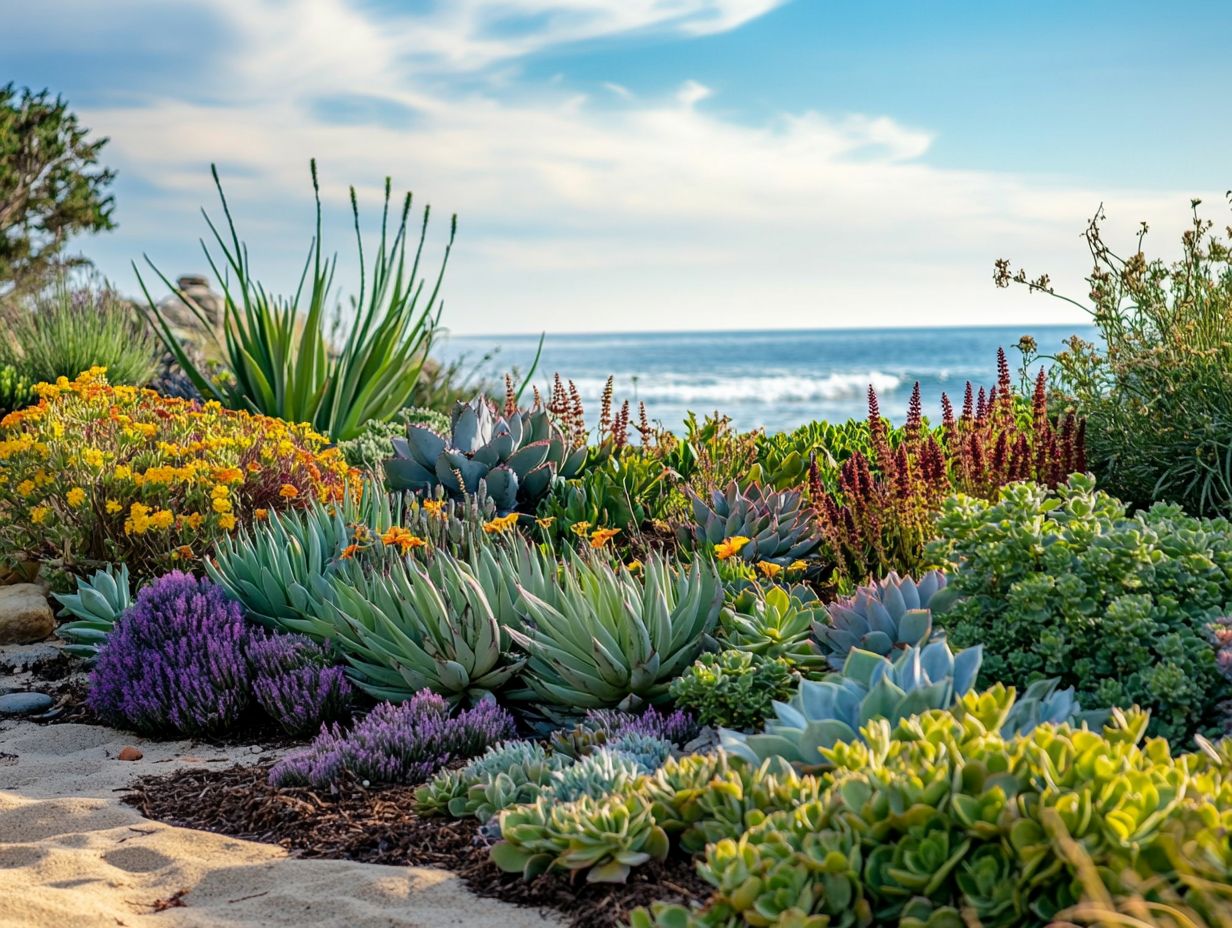
- Save water and beautify coastal landscapes with drought-resistant plants like agave, lavender, and verbena.
- These plants thrive in salty and dry conditions, making them perfect for coastal areas.
- With minimal upkeep and stunning looks, these plants are a smart choice for coastal homeowners.
1. Agave
Agave is a striking coastal plant known for its architectural elegance and impressive drought tolerance. It s ideal for gardens by the ocean, where conditions like sandy soils and fierce winds are common.
This resilient species thrives effortlessly in full sun and gracefully adapts to intense coastal rays while requiring minimal water once it s established. Its unique rosette shape adds a dramatic vertical element to your landscape, enriching your garden designs with a spectrum of colors and textures, ranging from vibrant greens to soft blues.
Landscape enthusiasts highly value its ability to thrive in poorly draining soil and sandy substrates, enabling it to flourish in even the most challenging coastal environments all while demanding minimal maintenance. Agave is truly the ideal selection for anyone aspiring to create a low-maintenance yet visually captivating coastal garden.
2. Lavender
The lavender plant is a cherished gem in coastal gardens, treasured not just for its delightful fragrance but also for its impressive drought tolerance and ability to thrive in Mediterranean climates.
You ll find several varieties, such as English lavender and French lavender, that flourish in coastal conditions, even in sandy, nutrient-poor soils. These resilient plants demand minimal watering, making them perfect for those who want to conserve water while still creating a vibrant outdoor space.
Caring for lavender is refreshingly straightforward, typically involving a simple pruning routine to encourage healthy growth and abundant blooms. Plus, their aromatic flowers attract pollinators like bees and butterflies, enhancing the garden’s biodiversity and enriching your outdoor experience with scents that evoke relaxation and joy.
3. Sea Holly
Sea Holly, especially the vibrant Eryngium Sapphire Blue, emerges as a stunning coastal plant, distinguished by its striking spiky flowers and exceptional salt tolerance. This makes it the perfect choice for gardens nestled near the ocean and enhances the appeal of coastal plants.
This remarkable plant thrives in sandy, well-draining soils and has an impressive ability to withstand periods of drought, ensuring it remains resilient even in challenging conditions.
With its bold bluish hues and silvery foliage, Sea Holly becomes a captivating focal point in coastal gardens, effortlessly blending with other native flora and ornamental grasses.
Its resilience against harsh sea spray only enhances its allure, allowing it to thrive in settings where many other plants might struggle. The unique aesthetic of Sea Holly elevates any coastal landscape, bringing both beauty and a hint of the wild to your garden.
Explore these plants and transform your coastal garden into a stunning, sustainable retreat!
4. Yucca
Yucca is often celebrated for its striking sword-like leaves and tall spikes of creamy flowers. It s the quintessential coastal plant, flourishing in tough environmental conditions while showcasing remarkable drought tolerance and adaptability to full sun.
Among the diverse species, varieties like Yucca gloriosa and Yucca filamentosa truly stand out. They expertly navigate the challenges of sandy, well-drained soils, which means soils that allow water to pass through easily, that coastal landscapes present.
These plants not only add a unique style to your garden but also demand minimal maintenance. They thrive with little more than occasional watering during dry spells.
Their tough foliage is unappetizing to deer, ensuring your garden remains undisturbed. When strategically placed, yuccas can elevate the vertical aesthetics of your outdoor space, enhancing visual interest and creating an eye-catching focal point.
5. Rosemary
Rosemary, that fragrant culinary herb, is more than just a staple in Mediterranean gardens; it’s also an exceptional drought-tolerant plant that flourishes in full sun and poor, rocky soils, particularly in coastal areas.
This hardy shrub boasts remarkable versatility, making it an ideal choice for your garden design. With its needle-like leaves and vibrant blue flowers, rosemary not only adds visual interest but also elevates your culinary creations, infusing dishes with its aromatic flavor.
Rosemary attracts pollinators like bees and butterflies, playing a crucial role in supporting biodiversity. To keep your rosemary thriving, provide well-drained soil and minimal water, as it prefers drier conditions.
In terms of propagation, you can easily use stem cuttings or seeds. Its resilience in coastal gardens makes rosemary a favorite among those looking to enhance their landscaping, offering both beauty and functional benefits.
6. Russian Sage
Russian Sage is a summer-blooming perennial that will undoubtedly captivate you with its soft, silver foliage and airy purple flowers. This plant is a must-have for your garden if you prioritize drought-tolerant landscapes.
This remarkable plant typically reaches heights of 3 to 4 feet, gracefully spreading and establishing a robust presence in your garden. Known for its resilience, Russian Sage thrives in poor, well-drained soils, which provide drainage and aeration, needing minimal maintenance once it s settled in.
Its flowering season runs from mid-summer to early fall, providing a stunning display that attracts pollinators and enhances the overall beauty of coastal gardens.
It harmonizes beautifully with other colorful plants, such as vibrant blooms and lush greenery, weaving a visually striking tapestry that embodies the essence of a thriving coastal environment.
7. Succulents
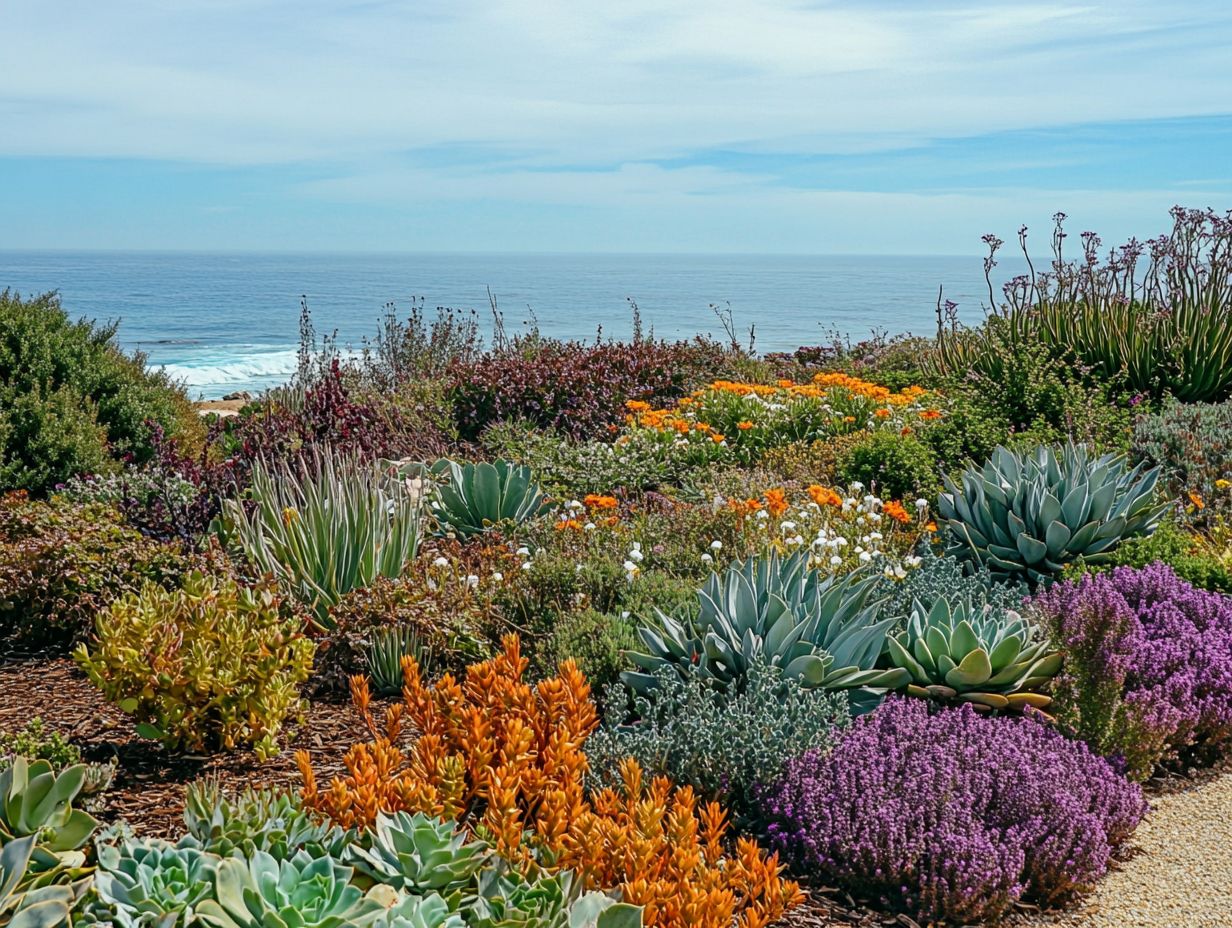
Succulents are an exceptional choice for your coastal garden, celebrated for their remarkable ability to store water and thrive in arid conditions. These plants are perfectly suited for rock gardens that bask in full sun and contend with poor soil.
Not only do these hardy plants add a touch of elegance to any outdoor space, but they also require minimal care. This makes them a top pick for gardeners who prefer low-maintenance options. Varieties like Sedum, Aloe, and Echeveria introduce vibrant colors and unique shapes, enhancing the textural diversity of your garden designs.
When planting, select well-draining soil and place them in locations where they can soak up the sun for most of the day. For propagation, simply take cuttings that will root effortlessly in dry soil, allowing you to expand your collection with ease and ensure your garden remains lush and vibrant in its coastal setting.
Choose these plants today and transform your coastal garden into a vibrant oasis!
8. Verbena
Verbena is a vibrant summer flower that effortlessly adds a splash of color to your coastal garden while boasting impressive drought tolerance.
You’ll find that various species, such as the creeping Verbena and tall Verbena bonariensis, are particularly well-suited for coastal environments.
These varieties offer enchanting blooms from early spring through late fall, captivating all with their rich hues. Maintenance is a breeze just a bit of occasional deadheading to encourage growth.
Their resilience against salty air and sandy soils makes them ideal choices for seaside landscapes.
These flowers not only beautify your garden but also serve as a magnet for beneficial insects like butterflies and bees, enhancing the biodiversity of your space.
Incorporating plants like sea campion can attract even more pollinators, contributing to the overall ecological health.
9. Lantana
Lantana is a dynamic and colorful plant that thrives in sunny coastal gardens, renowned for its vibrant flowers and impressive drought tolerance.
This hardy perennial doesn’t just catch the eye; it excels in a variety of soil conditions, making it a superb choice for gardeners like you who want to enhance their landscapes.
With its minimal requirements for water and nutrients, this resilient species plays a crucial role in supporting local ecosystems, offering habitats and food sources for beneficial insects.
Its continuous blooming cycle weaves a rich tapestry of colors into coastal gardens, effortlessly elevating aesthetic charm and creating a lively atmosphere throughout the growing season.
10. Bougainvillea
Bougainvillea is a stunning tropical vine that can effortlessly elevate your garden with its vibrant foliage and extraordinary resilience in coastal landscapes.
If you re on the lookout for drought-tolerant plants that flourish in full sun, this is an absolute must-have for your garden!
Picture a stunning tapestry of colors bursting to life, from deep magentas to bright oranges, creating a dazzling display that catches the eye and enlivens your outdoor space.
Cultivating Bougainvillea is remarkably straightforward, requiring minimal care once it’s established.
Its robust nature allows it to withstand strong winds, making it perfectly suited for coastal gardens where many other plants might struggle.
To encourage optimal growth, be sure to train the vine along trellises or fences. This not only allows it to spread gracefully but also helps maintain its vigorous character.
With just a little effort, you can transform your outdoor area into a vibrant paradise, showcasing the undeniable beauty of this resilient plant.
What Makes These Plants Drought-Resistant?
The drought-resistant qualities of various coastal plants stem from specific adaptations that empower them to thrive in challenging environments characterized by sandy soils, high salt levels, and limited water availability. Exploring 10 unique drought-resistant plants for your garden can enhance your gardening efforts in such conditions.
These remarkable plants showcase an array of special traits that enhance their moisture conservation and resilience in arid landscapes.
For example, many have developed deep root systems that delve deep into the ground, tapping into hidden water sources.
Their leaves are often coated with a waxy surface that effectively reduces water loss by curbing evaporation.
Such adaptations are particularly pronounced in Mediterranean flora, where traits like thickened leaves and specialized pores equip them to endure extreme weather fluctuations.
The collective effectiveness of these features not only secures their survival but also plays a vital role in maintaining the unique ecological balance of coastal ecosystems.
How Do These Plants Thrive in Coastal Areas?
Coastal plants flourish in their unique environments by developing specific traits that enable them to tackle the challenges posed by salt spray, high winds, and poor soil conditions typical of these regions. These adaptations, such as salt tolerance, allow them to retain vital water and nutrients even in harsh saline conditions.
Additionally, their wind resistance ensures they maintain structural integrity and prevent damage during storms. Their ability to thrive in sandy soils often lacking essential nutrients demonstrates efficiency in utilizing minimal resources for survival.
The presence of native plants in coastal ecosystems is essential. They engage in mutually beneficial partnerships with local wildlife and soil organisms, promoting biodiversity, enhancing soil stability, and fostering a resilient environment that benefits both plant and animal communities.
What Are the Maintenance Requirements for These Plants?
The maintenance requirements for coastal plants can differ significantly. Understanding their needs, such as soil type, watering schedules, and seasonal care, will help you cultivate a thriving garden in challenging coastal environments.
To nurture these resilient varieties effectively, establishing a consistent watering routine is essential, especially during dry spells. Deep watering every two to three weeks helps the roots anchor firmly in the soil.
Well-draining sandy soils typically need little amendment to retain moisture. Adding organic compost can boost nutrient availability and foster healthier growth.
For pest management, focus on natural deterrents. Introducing beneficial insects or utilizing neem oil applications can effectively control infestations without disrupting the ecosystem. Mulching significantly helps homeowners by reducing weed competition and conserving soil moisture, making overall garden maintenance easier.
How Do These Plants Enhance the Aesthetics of Coastal Landscapes?
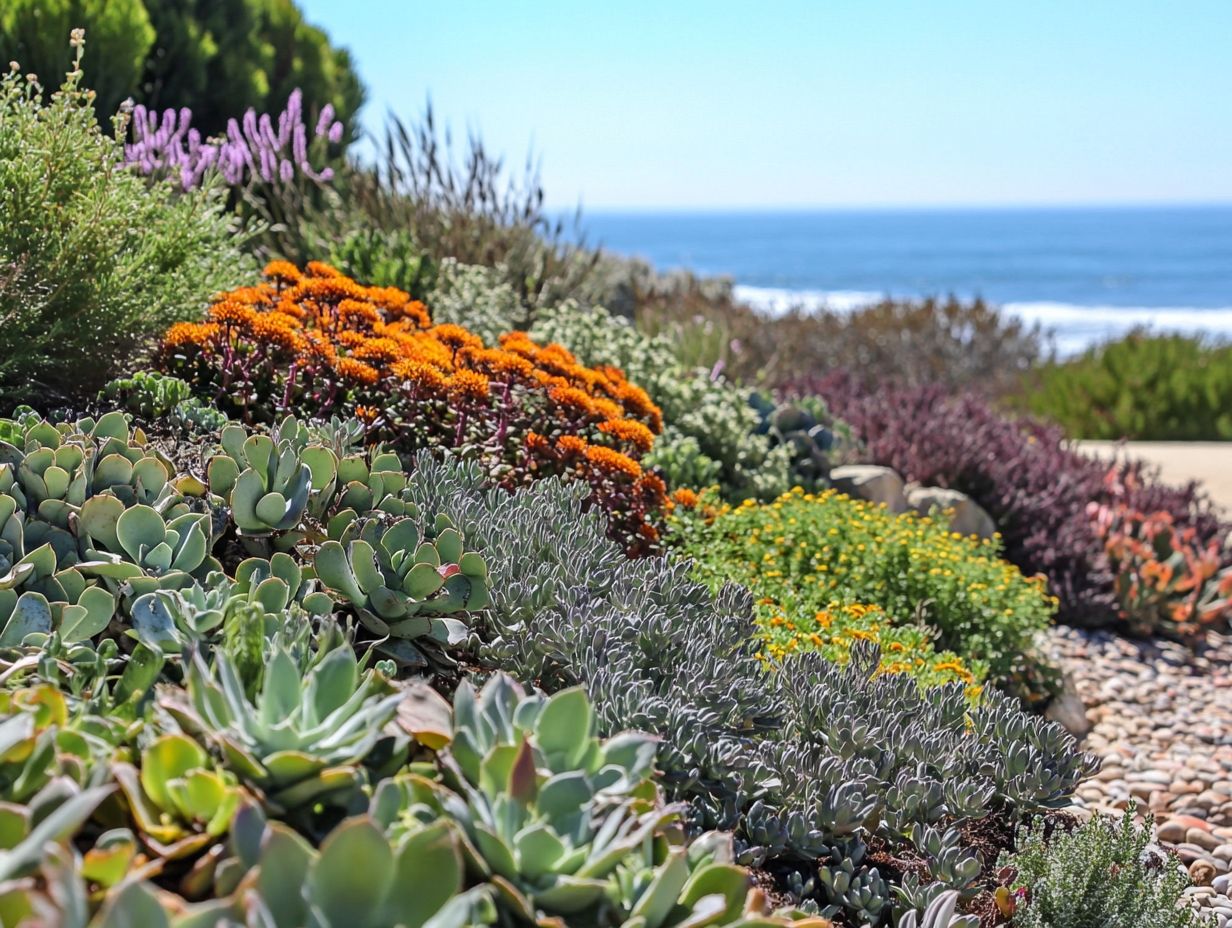
Transform your landscape with coastal plants stunning colors and unique forms! These plants craft visually stunning gardens that mirror the natural beauty of coastal environments.
By thoughtfully incorporating a variety of coastal species, you can achieve a striking visual impact that captivates the eye and evokes the tranquil essence of seaside habitats. The interplay of contrasting colors among different plants draws attention to key features.
Seasonal blooms offer a dynamic, ever-changing display throughout the year. Utilize elements to create focal points, like a grouping of bold succulents or a driftwood accent, guiding visitors’ gaze and inviting exploration of your garden.
This approach enhances your garden’s beauty and invites tranquil moments of reflection!
Are There Any Potential Risks or Drawbacks of These Plants?
While many coastal plants bring a host of benefits, they also come with potential risks and drawbacks. These include invasive growth habits, vulnerability to pests, and specific care requirements that might pose challenges for some gardeners.
Such drawbacks can raise ecological concerns, particularly when these plants escape into non-native environments, potentially disrupting local ecosystems. Their aggressive growth can outcompete native flora, leading to reduced biodiversity and upsetting the balance within coastal habitats.
To navigate these risks, prioritize selecting native or well-behaved varieties. Remain vigilant in monitoring their growth patterns. By implementing thoughtful care practices, such as regular pruning and using barriers to control their spread, you can mitigate potential issues while relishing the aesthetic and environmental advantages that these coastal plants offer.
How Can Homeowners Incorporate These Plants into Their Gardens?
You can successfully incorporate drought-tolerant coastal plants into your garden by understanding their unique needs. Selecting combinations that complement your landscaping style and environmental conditions can also include options like low-water plants for sustainable landscapes.
Start by assessing your local climate, soil type, and coastal conditions. This will ensure that the plants you choose can thrive in salty air and fluctuating moisture levels. Opt for a variety of textures and colors to create visual harmony that enhances your outdoor space. Remember, spacing is crucial; each plant needs room to grow for healthy growth and proper air circulation.
Consider your personal aesthetics as well. Blend practical choices with elements that bring you joy. Mimic the natural coastal ecosystems while ensuring that your garden remains functional.
What Are Some Other Drought-Resistant Plants That Can Thrive in Coastal Areas?
Beyond familiar varieties, you’ll find a wealth of drought-resistant plants for coastal areas that flourish in these environments. Many of these are native to North America, enhancing biodiversity and contributing to the resilience of your garden design.
These plants conserve water effectively, requiring minimal irrigation while offering vital habitats for local wildlife. Consider the vibrant seaside goldenrod (Solidago sempervirens) and the hardy beach strawberry (Fragaria chiloensis); both add unique colors and textures to your landscape. For more options, explore the top 10 drought-resistant ground covers for gardens.
Incorporating species like salt-tolerant beach grass (Ammophila breviligulata) can stabilize sandy soils while creating a lush coastal environment. By planting clusters of these drought-resistant plants for low maintenance, you enrich ecological health and provide food and shelter for pollinators and small creatures. This fosters a thriving ecosystem that harmonizes beautifully with coastal conditions.
How Can These Plants Benefit the Environment?
Drought-resistant coastal plants offer numerous environmental benefits. They enhance soil health, support wildlife habitats, and significantly contribute to water conservation in coastal ecosystems. For inspiration, consider exploring 10 stunning drought-resistant plants for your garden.
These resilient plants play a crucial role in stopping soil loss, making them essential for a healthy coastal garden! They stabilize shorelines with robust root systems, binding the soil and reducing runoff during heavy rains. By attracting various pollinators, such as bees and butterflies, they cultivate a vibrant ecosystem that promotes biodiversity.
This rich diversity is vital for maintaining balanced ecosystems. It supports local flora and fauna while enhancing the aesthetic and recreational value of coastal areas ultimately benefiting the surrounding communities. Start your coastal garden to experience these benefits firsthand!
What Are Some Tips for Successfully Growing and Caring for These Plants in Your Coastal Garden?
Successfully nurturing drought-tolerant coastal plants requires understanding their unique needs. For optimal results, consider incorporating some of the top 10 drought-resistant plants for water-saving gardens. Focus on proper watering techniques, planting in full sun, and soil preparation for poor soil. Timely pruning fosters robust growth.
Consider the specific environmental conditions of your coastal area; factors like salt exposure and wind can significantly impact your plants’ health. Regularly monitor soil moisture levels, especially in sandy soils. Deep watering once or twice a week typically suffices, allowing roots to establish without becoming waterlogged.
Incorporating amendments like compost and coarse sand enhances drainage. Seasonal practices like mulching help retain moisture and keep weeds at bay, especially with salt-tolerant plants. By adding ornamental grasses and fragrant flowers to your garden, you’ll encourage air circulation, enabling your plants to flourish in harsh coastal conditions.
What Are the Best Ways to Conserve Water in Coastal Landscapes with Drought-Tolerant Plants?
Conserving water in coastal landscapes is crucial, especially during drought conditions. You can effectively achieve this by incorporating drought-tolerant plants, mulching, and using smart watering methods.
Choosing native species that are native to North America and already acclimated to your local climate can significantly reduce your water needs. It’s essential to maintain well-drained soil, which enhances water retention and supports overall plant health. Techniques like composting and using cover crops, such as pink sea thrift (Armeria maritima), improve soil structure, allowing it to absorb and retain moisture more effectively.
Adopting smart watering methods like drip irrigation or rainwater harvesting ensures that every drop is used efficiently. This approach benefits even fast-growing coastal garden flora, minimizes waste, and nurtures your coastal garden.
Frequently Asked Questions
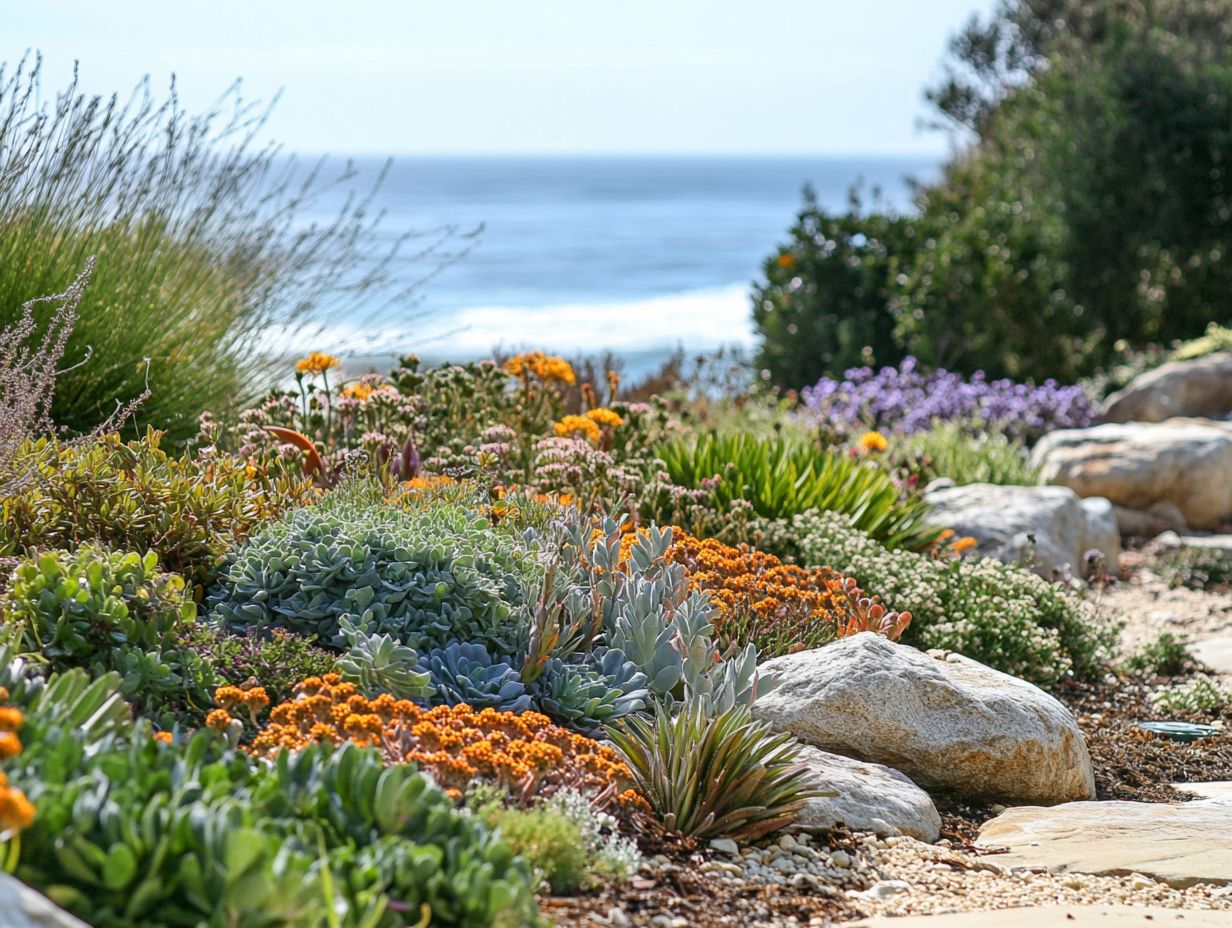
What Are Some Examples of Drought-Resistant Plants for Coastal Areas?
Some examples include sea holly, sea campion, sea lavender, coastal buckwheat, beach strawberry, seaside daisy, succulents, and yarrow.
Are Drought-Resistant Plants Suitable for All Climates?
No, drought-resistant plants are specifically adapted to thrive in hot and dry environments. They may not do well in cooler or wetter climates.
Why Are Drought-Resistant Plants Recommended for Coastal Areas?
Coastal areas tend to have lower rainfall and higher temperatures, making it challenging for some plants to survive. However, drought-resistant plants, like lavender and prickly pear, thrive in these conditions and require less water to stay healthy.
Do Drought-Resistant Plants Require Any Special Care?
While these plants are adapted to survive in dry conditions, they still need proper care and maintenance. This includes regular watering during the establishment period and occasional fertilization.
Can Drought-Resistant Plants Be Used for Landscaping in Coastal Areas?
Yes, drought-resistant plants can enhance landscaping in coastal areas. Colorful plants are often recommended for their ability to withstand harsh coastal conditions, making them a great choice for your garden.
Do Drought-Resistant Plants Attract Wildlife?
Absolutely! Many drought-resistant plants, such as Mexican feather grass and yarrow, attract pollinators like bees and butterflies. They also provide food and shelter for birds and other small animals.

